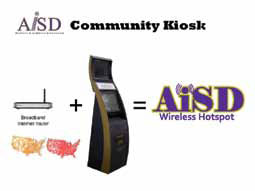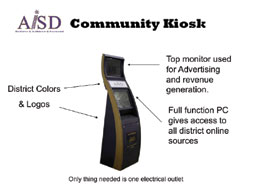WiFi for Sale

The Alvarado ISD in Texas had a challenge: getting the community connected. The district comprises 3,400 students on six campuses spread across almost 100 square miles. About 75% of these students come from economically disadvantaged households. This community not only has difficulty meeting the cost associated with acquiring service, but some families are so rural, they don’t even have the physical ability to get service at home. With students being issued laptop devices, the district knew it had to find a way to get students connected outside of the school building.
The Solution: C.L.I.C.K.
The school worked with the community to develop community-based Internet hot spots that would allow anyone to gain access to the Internet and AISD resources for free. The result? C.L.I.C.K — Community Located Internet Connected Kiosks. The program began with five community kiosks, which are located in restaurants, retail stores, grocery stores, and anywhere there is an electrical outlet. They feature:
• Dual display
• Fully functioning PC with Internet access
• Broadband Internet hotspot
• District branding
Each kiosk displays the district colors and logos and includes advertising to generate revenue. Below the ads is a fully functioning PC that provides access to all district online sources.
Why Advertising?
Advertising on school-related items is not without its critics, but the district felt that the benefits outweighed any negatives. The kiosks allow multiple companies to advertise, and include access to an advertiser’s Web site and location mapping. Advertisers pay a monthly fee to display on all units. Businesses hosting the kiosks saw an increase in customer traffic and in the time customers spent at their location. And, the partnership between AISD and the community provides a great opportunity to promote the district’s work.
Tools and ideas to transform education. Sign up below.
The biggest perk? The revenue generated from these ads allows the community free wireless Internet access for customers 24/7. Community members can do anything from the kiosks that you can do online; they provide Internet access to both students and their families.

Getting Connected
The community kiosk program has been in place for more than two years in Alvarado, thanks to the support of advertising and sponsorship. The community has embraced the program and the feedback from parents and students has been tremendous. The positive impact of connecting the community to the Internet was not a surprise--but the number of requests from business and other locations for kiosk units was.
One of the most interesting requests for a kiosk came from a local judge who asked the district to place a kiosk at the courthouse. The judge wanted to make this wifi access point available so parents could access information about their children, such as attendance or other issues . There would be no excuses for not knowing about their child’s school activities: the kiosk made this information readily available.
Thanks to revenue gained from advertising, the program now has the possibility of expanding to other kiosk-based wifi access points in other areas of the city. I will take this program with me as I move from Alvarado ISD to my new job at Cedar Hill ISD. We will roll out five units within the next month, and plans for more are already underway.
Connecting the community and the school district is a win-win for everyone and the community kiosks program achieves just that.
Kyle Berger has over 12 years of K12 IT leadership experience and has been recognized for his work in advancement of student technology and one to one initiatives as well as bring your own device environments. Kyle is currently the Executive Director of Cedar Hill ISD located in North Texas. Kyle.berger@chisd.net
